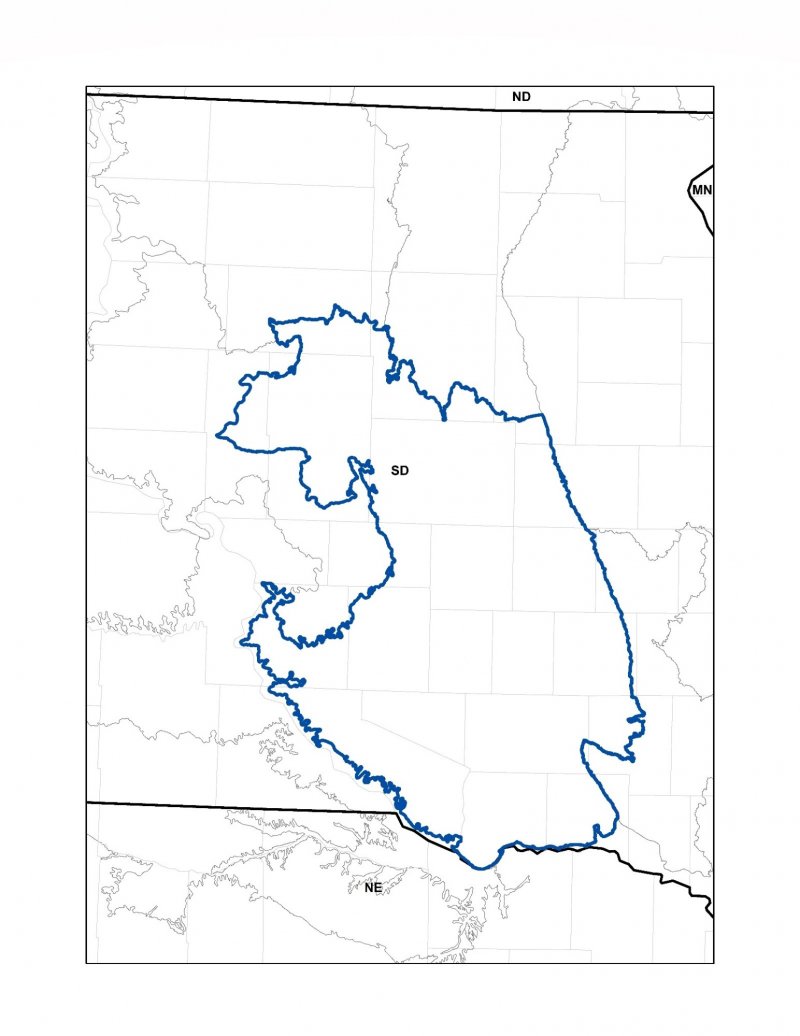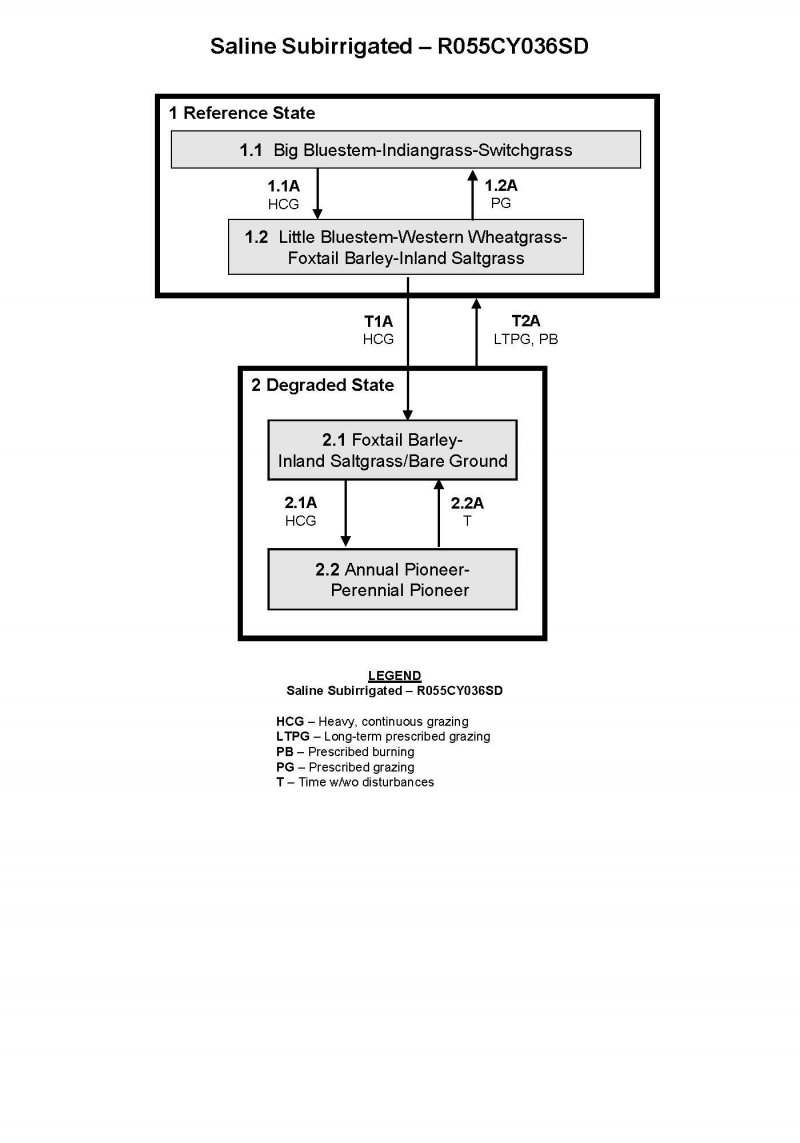
Natural Resources
Conservation Service
Ecological site R055CY036SD
Saline Subirrigated
Last updated: 2/01/2024
Accessed: 11/21/2024
General information
Provisional. A provisional ecological site description has undergone quality control and quality assurance review. It contains a working state and transition model and enough information to identify the ecological site.
MLRA notes
Major Land Resource Area (MLRA): 055C–Southern Black Glaciated Plains
The Southern Black Glaciated Plains (55C) is located within the Northern Great Plains Region. It is entirely within South Dakota encompassing about 10,835 square miles (Figure 1). The elevation ranges from 1,310 to 1,970 square feet. The MLRA is on nearly level to undulating glacial till plains interrupted by steeper slopes adjacent to streams and moraines. The James River is an under-fit stream. Its valley was carved by floodwaters draining glacial Lake Dakota and is filled with glacial outwash and alluvial deposits. (USDA-NRCS, 2006).
The dominant soil order in this MLRA is Mollisols. The soils in the area dominantly have a mesic soil temperature regime, an ustic soil moisture regime, and mixed or smectitic mineralogy. They generally are very deep, well drained to very poorly drained, and clayey or loamy. This area supports natural prairie vegetation characterized by western wheatgrass (Pascopyrum smithii), green needlegrass (Nassella viridula), needle and thread (Hesperostipa comata), and porcupinegrass (Hesperostipa spartea) with Prairie cordgrass (Spartina pectinata), and reed canarygrass (Phalaris arundinacea) as the dominant vegetation on the poorly drained soils. (USDA-NRCS, 2006).
Classification relationships
Major Land Resource Area (MLRA): Southern Black Glaciated Plains (55C) (USDA-NRCS, 2006)
USFS Subregions: North Central Glaciated Plains Section (251B); Yankton Hills and Valleys Subsection (251Bf); Western Glaciated Plains Section (332B); James River Lowland Subsection (332Bb); North Central Great Plains Section (332D); Southern Missouri Coteau Slope Subsection (332Dd); Southern Missouri Coteau Subsection (332De) - (Cleland et al., 2007).
US EPA Level IV Ecoregion: Southern Missouri Coteau (42e); Southern Missouri Coteau Slope (42f); James River Lowland (46n) - (USEPA, 2013)
Ecological site concept
The Saline Subirrigated ecological site typically occurs along the edges of drainageways or closed depressions. Soils are somewhat poorly drained which have a water table within 2 to 5 feet of the soil surface that persists longer than the wettest part of the growing season, typically until the month of August. The soils will have visible salts within 16 inches of the soil surface. Dominant vegetation is adapted to the high salinity. Vegetation in the Reference State is dominated by warm-season grasses including big bluestem, Indiangrass, and switchgrass. Forbs include seepweed, goldenrods, and cinquefoil. Change in disturbance regime may lead to a Degraded State where foxtail barley and inland saltgrass are common
Associated sites
| R055CY002SD |
Linear Meadow These sites occur in drainageways. Soils are poorly and very poorly drained and have a water table within 0 to 2 feet of the soil surface that persists longer than the wettest part of the growing season, typically until the month of August. The central concept soil series is Lawet, but other series are included. |
|---|---|
| R055CY003SD |
Subirrigated These sites occur in drainageways. Soils are somewhat poorly drained and have a water table within 2 to 5 feet of the soil surface that persists longer than the wettest part of the growing season typically until the month of August. The central concept soil series is Crossplain, but other series are included. |
| R055CY004SD |
Wet Meadow These sites occur in a basin or closed depression. Soils are poorly drained and the site ponds water for 4 to 8 weeks in the spring of the year or after a heavy rain. The central concept soil series is Tetonka, but other series are included. |
| R055CY006SD |
Limy Subirrigated These sites occur along the edges of drainageways. Soils are somewhat poorly drained and have a water table within 2 to 5 feet of the soil surface that persists longer than the wettest part of the growing season, typically until the month of August. Soils will effervesce with acid at or near the surface. The central concept soil series is Davison but other series are included. |
| R055CY007SD |
Saline Lowland These sites typically occur in drainageways, but can occur along the edges of larger closed depressions. Soils are poorly and very poorly drained and have a water table within 0 to 2 feet of the soil surface that persists longer than the wettest part of the growing season, typically until the month of August. The soils will have visible salts within 16 inches of the soil surface. The central concept soil series is Salmo, but other series are included. |
Similar sites
| R055CY006SD |
Limy Subirrigated The Limy Subirrigated site is in a similar landscape position, but will not have visible salts within 16 inches of the soil surface. The Limy Subirrigated site will have more little bluestem and more green needlegrass than a Saline Subirrigated site. |
|---|
Table 1. Dominant plant species
| Tree |
Not specified |
|---|---|
| Shrub |
Not specified |
| Herbaceous |
(1) Andropogon gerardii |
Click on box and path labels to scroll to the respective text.
Ecosystem states
| T1A | - | Heavy continuous grazing |
|---|---|---|
| T2A | - | Long term prescribed grazing, prescribed burning |
State 1 submodel, plant communities
| 1.1A | - | Heavy continuous grazing |
|---|---|---|
| 1.2A | - | Prescribed grazing with recovery periods |
State 2 submodel, plant communities
| 2.1A | - | Heavy continuous grazing |
|---|---|---|
| 2.2A | - | Time w/wo disturbance |


